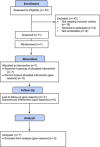Famotidine, a Histamine H2 Receptor Antagonist, Does Not Reduce Levodopa-Induced Dyskinesia in Parkinson's Disease: A Proof-of-Concept Study
- PMID: 30363717
- PMCID: PMC6182979
- DOI: 10.1002/mdc3.12061
Famotidine, a Histamine H2 Receptor Antagonist, Does Not Reduce Levodopa-Induced Dyskinesia in Parkinson's Disease: A Proof-of-Concept Study
Abstract
The neural mechanisms underlying levodopa-induced dyskinesia (LID) in Parkinson's disease (PD) may involve histamine (H2) receptors on striatopallidal pathways. We recently demonstrated that the clinically available oral histamine H2 receptor antagonist (H2 RA), famotidine, can reduce l-dopa-induced chorea in MPTP-lesioned macaques. We hypothesized that famotidine may be useful in the treatment of LID in PD patients. We performed a proof-of-concept, double-blind, randomized, multiple cross-over (4×) trial. Seven PD subjects with bothersome dyskinesia were randomized to oral famotidine 80, 120, and 160 mg/day and placebo. Each subject was randomized to receive each of the four treatment phases for 14 days followed by a 7-day wash-out period between each treatment phase. The primary outcome measure was change in the Unified Dyskinesia Rating Scale (UDysRS; part III) between placebo and famotidine. Secondary outcomes were UDysRS (parts I and II), Global Impression of Change, Lang-Fahn Activities of Daily Living Dyskinesia Scale, Unified Parkinson's Disease Rating part III, and adverse events (AEs). Outcomes were evaluated pre- and post-treatment per dose and analyzed using a mixed-effects linear model. There was no significant effect of famotidine treatment on any of the primary or secondary outcome measures compared to placebo (each dose and all doses combined). There were no significant AEs. Even though the sample size of the current study is limited, famotidine seems to be safe in patients with PD and LID, but showed no potential as an antidyskinetic agent.
Keywords: H2 antagonist; Parkinson's disease; dyskinesia; famotidine; histamine.
Figures
References
-
- Fox SH. Non‐dopaminergic therapies for the motor symptoms of Parkinson's disease. Drugs 2013;73:1405–1415. - PubMed
-
- Vizuete ML, Traiffort E, Bouthenet ML, Ruat M, Souil E, Tardivel‐Lacombe J, Schwartz JC. Detailed mapping of the histamine H2 receptor and its gene transcripts in guinea‐pig brain. Neuroscience 1997;80:321–343. - PubMed
-
- Sittig N, Davidowa H. Histamine reduces firing and bursting of anterior and intralaminar thalamic neurons and activates striatal cells in anesthetized rats. Behav Brain Res 2001;124:137–143. - PubMed
-
- Prast H, Tran MH, Lamberti C, Fischer H, Kraus M, Grass K, Philippu A. Histaminergic neurons modulate acetylcholine release in the ventral striatum: role of H1 and H2 histamine receptors. Naunyn Schmiedebergs Arch Pharmacol 1999;360:552–557. - PubMed
-
- Nomoto M, Thompson PD, Sheehy MP, Quinn NP, Marsden CD. Anticholinergic‐induced chorea in the treatment of focal dystonia. Mov Disord 1987;2:53–56. - PubMed
LinkOut - more resources
Full Text Sources
Other Literature Sources



